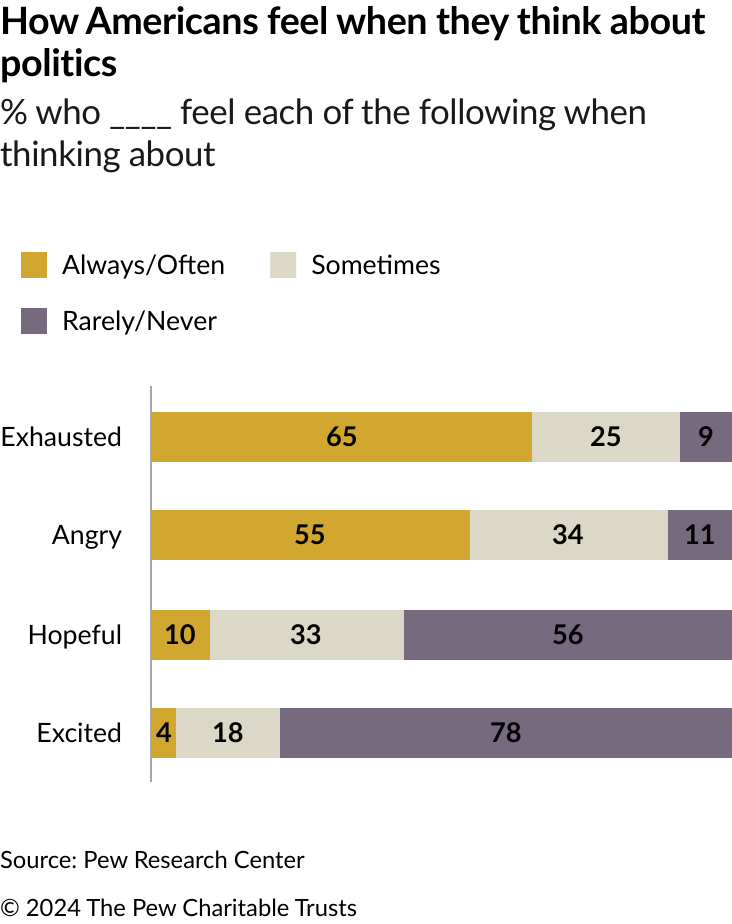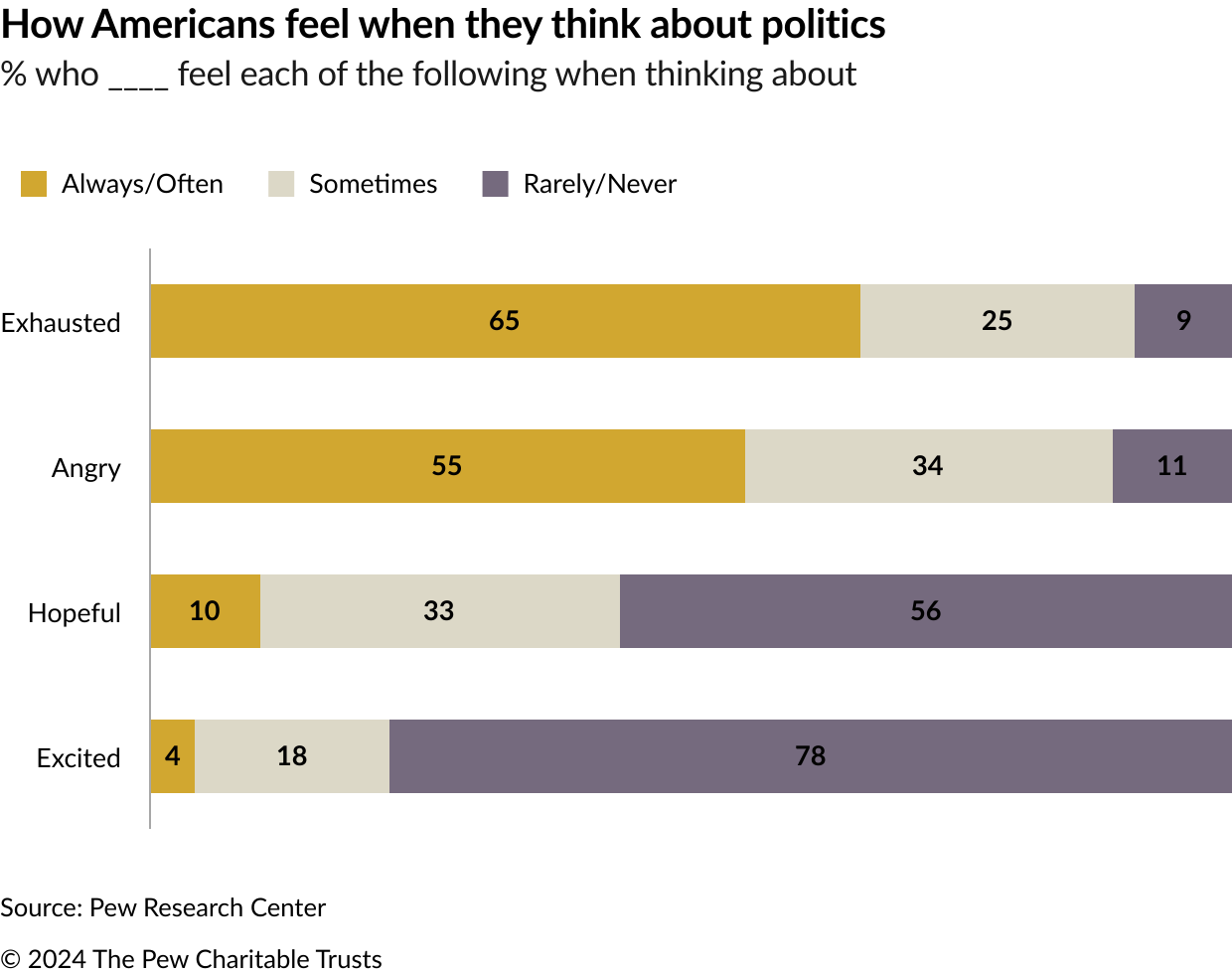Navigating the Challenges of the U.S. Political Landscape
A Pew Research Center survey finds that Americans’ views of politics and elected officials are unrelentingly negative—with little hope of improvement

Heading into this year’s presidential election, Americans are profoundly disillusioned with the state of the nation’s politics—more so than in decades.
Disgusting, divisive, dysfunctional. Corrupt, crazy, confusing. Broken, bad, sad. These were among the negative terms that 8,480 members of the Pew American Trends Panel came up with when they were asked to use one word or phrase to describe politics today.
Another term often used in a September report by Pew Research Center—aptly titled “Americans’ Dismal Views of the Nation’s Politics”—was “exhausted.” Almost two-thirds of participants said they were mostly or always exhausted with politics, and 55% said they were often or mostly angry. Only 10% said they were mostly hopeful.
There’s more: Americans are dissatisfied with the people running for president in 2024 (63%), the survey found; nearly 6 in 10 (56%) gave no answer or said “nothing” when invited to identify a strength in the American political system; just 4% said the system is working extremely or very well; and about 6 in 10 (63%) expressed “not too much” or zero confidence in the future of the system.
“It wasn’t just a negative picture; it was deeply negative,” says Carroll Doherty, the Center’s director of political research. “We found very harsh responses to the way politics is going today. People have always made fun of politicians and been cynical about them, but this is a new level.”
Overwhelming majorities of Americans said that lobbyists and special interests hold too much sway in politics, that presidential elections last too long and cost too much, and that both Republicans and Democrats are more focused on fighting each other than on solving the nation’s problems.
“The report has a warning quality to it for elected officials of both parties,” Doherty says. “This dissatisfaction is very deep and very broad, and it’s not going away. Confidence in the future is very low. It definitely is a sign that people don’t think things are working very well.”
Historically, dismay with the system has led to low voter turnout. Yet voter turnouts in 2018, in 2020, and again in 2022 were the highest in decades for each respective slot in the election cycle.
Doherty says the higher turnouts appear to be the product of fear and anger, which cut across all categories of age, race, sex, and education—and even political affiliation.
“People on both sides—especially the partisans, who are really dug in—think that there would be disastrous consequences if the opponent won the election,” Doherty says. “I think that is what is driving turnout. It is fear of what might happen if their side loses.”
Kathleen Hall Jamieson, director of the Annenberg Public Policy Center at the University of Pennsylvania, agrees that fear is driving turnout. But she finds hope in seeing that Americans still care enough to vote—because it means that they haven’t entirely given up on the system.
“The survey does have some good news,” Jamieson says. “If you landed from Mars and looked at the survey, you would say, ‘This is really dismal.’ But the fact that a reasonable percentage of people still think their vote makes a difference—that is really important. If you are giving up on the system—that is, if you don’t think there is any chance it is going to change—then you are in a far worse place.”
Jamieson praised the scope of the survey of Pew’s American Trends Panel members, who represent a randomly selected sample of U.S. adults. The poll was conducted online in July 2023 in both English and Spanish.
“This is a master survey,” Jamieson says. “We have seen pieces of this in other surveys, but this puts it all together.” Although the survey asked precise questions, she says, it also gave respondents the open-ended chance to voice their feelings.
She notes that although around half of respondents couldn’t or wouldn’t name a single strength in the political system, 12% of respondents who did name a strength cited constitutional structures of government. Americans who paid attention to their civics lessons, she says, have learned that having three independent branches of government—president, Congress, and the courts—provides stability in troubled times.

And the survey certainly underscored that these are troubled times. Just 16% of the public—among the smallest share in seven decades—trusts the federal government to do the right thing at least most of the time, the survey says. Distrust is widespread, but Republicans feel it the most: About half as many Republicans as Democrats—26% versus 54%—agreed with a statement that “the federal government does more for ordinary Americans than people give it credit for.”
Jamieson also takes note of the decline of public confidence in the Supreme Court, which, when compared to the president and Congress, “always in the past seemed immune to the public perception that everything is going wrong,” she says. Now, a majority of Americans—54%—have an unfavorable opinion of the court.
The political parties fare no better. Since the mid-1990s, the percentage of Americans holding an unfavorable view of both major parties has quadrupled, with 61% now holding a dim view of the Republicans and 60% having a negative view of the Democrats. Many people say they would welcome a third party, but the survey also found considerable skepticism that more parties would make it easier to solve the nation’s problems.
The Americans who are most engaged in politics are the ones feeling the most worn out, with 72% of highly politically engaged adults saying that, always or most of the time, they feel exhausted. The exhaustion goes beyond interaction with government or politicians; it intrudes into families, neighborhoods, and workplaces, with the research showing that 61% of U.S. adults find it stressful and frustrating to discuss politics with people who hold different views from their own. The level of that frustration is up by 11% since 2019—influenced, no doubt, by the highly fraught 2020 election and its aftermath.
The New York Times, in an article that referenced the Center’s survey, suggested that the United States is “a country unified by discontent.” Doherty says it is also a country united by the desire for change. Despite the public’s malaise, the survey found enthusiasm for a number of significant changes that might improve the system.
Among the popular ideas for changes are imposing term limits on members of Congress, imposing age limits on all elected federal officials and Supreme Court justices, and eliminating the Electoral College to have presidential elections determined by the popular vote.
Among other potential changes, Republicans are nearly unified (93%) in supporting a requirement that all voters present a government-issued photo ID at the polls, as opposed to 61% of Democrats favoring such a requirement. Conversely, Democrats are much more in favor (80%) than are Republicans (45%) of automatic voter registration for all eligible citizens.
More Democrats than Republicans favor increasing the number of justices on the Supreme Court, but around half of survey respondents are not enamored with the idea.
More young adults than older adults favor making structural changes to Congress—expanding the size of the House of Representatives and altering the manner in which the 50 states are represented in the Senate. Neither of these ideas have majority support from all survey respondents.
And with legislatures in some states seeking state-level solutions to nationally divisive matters, including social issues such as abortion, a majority of people (54%) say they’re extremely or very concerned that their personal rights could depend on what state they live in. Democrats feel this more strongly than Republicans do.
As the nation barrels into this year’s elections—which will decide the presidency, control of Congress, and many state offices across the land—the public’s nerves are clearly frayed.
“We’re headed into a presidential election where people are feeling negative, at the moment at least, about their choices,” Doherty says. “The desire for change from the status quo crosses party lines. The public is not aligned on everything, but there’s definitely a lot of sentiment for change of some sort.”
Tom Infield is a longtime Philadelphia journalist and frequent contributor to Trust.








